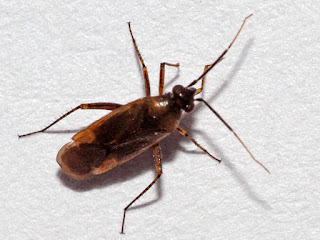Mouse Moth, North Elmham, 21st August
Blackthorn Slender Parornix torquillella (male, gen det), North Elmham, 21st August
My second ever Small Silver Sedge Lepidostoma hirtum followed one night after my first. Other caddisflies were Oxyethira flavicornis, 2 Hydropsyche siltalai, 2 Hydropsyche pellucidula and Medium Sedge Goera pilosa.
Beetles included 2 Trechus quadristriatus, a new species for me.
Trechus quadristriatus, North Elmham, 21st August
Other beetles were 5 Bradycellus verbasci and 2 Aphodius rufipes. Other insects included the mayfly Pond Olive Cloeon dipterum, the green lacewing Nineta vittata, a female Conwentzia sp. Waxfly, the brown lacewing Micromus variegatus and 9 Forest Bugs (aka Red-legged Shieldbugs).
Nest day a quick look round Wells Wood produced a few insects including my first Plagiognathus arbustorum (a mirid bug) feeeding on Fleabane.
Plagiognathus arbustorum, Wells, 22nd August
Moths included Common Grass-veneer Agriphila tristella and Small Fan-footed Wave.
That night Dave and I headed back to Frost's Common, a site we'd been planning to trap at for a long while. The Norfolk Moth Survey event there was a wash-out so we thought we'd try again on a better night. Conditions weren't ideal but we managed 47 species including a few mildly interesting ones: Oak Carl Tischeria ekebladella, 3 Brown Birch Slenders Parornix betulae, 2 Golden Argents Argyresthia goedartella, Bird-cherry Ermine Yponomeuta evonymella, Birch Ermel Swammerdamia caesiella, Chamomile Conch Cochylidia implicitana, Chequered Fruit-tree Tortrix Pandemis corylana, 2 Common Marbles Celypha lacunana, 3 Birch Marbles Apotomis betuletana, Rush Marble Bactra lancealana, Small Birch Bell Epinotia ramella, 2 Pearl Veneers Agriphila straminella, Barred Grass-veneer Agriphila inquinatella, 6 Ground-moss Greys Eudonia truncicolella, 3 Brown China-marks Elophila nymphaeata, 7 Ringed China-marks Parapoynx stratiotata, 3 Small China-marks Cataclysta lemnata, 3 Mother of Pearls Pleuroptya ruralis, Meal Moth Pyralis farinalis (only my second ever), Double-striped Knot-horn Cryptoblabes bistriga, Dotted Oak Knot-horn Phycita roborella, 2 Maiden's Blushes, 3 Common Carpets, Yellow Shell, 2 Purple Bars, 5 Green Carpets, 5 Double-striped Pugs, Yellow-barred Brindle, 5 Brimstone Moths, 2 Common Waves, 3 Light Emeralds, Poplar Hawk-moth, Dingy Footman, 2 Buff Footmen, 3 Common Footmen, Shuttle-shaped Dart, 4 Flame Shoulders, Large Yellow Underwing, Lesser Yellow Underwing, Lesser Broad-bordered Yellow Underwing, Setaceous Hebrew Character, 2 Common Wainscots, Svensson's Copper Underwing, Burnished Brass, Spectacle, 10 Straw Dots and 2 Snouts.
Chamomile Conch Cochylidia implicitana, Frost's Common, 22nd August
Meal Moth Pyralis farinalis, Frost's Common, 22nd August
Double-striped Knot-horn Cryptoblabes bistriga, Frost's Common, 22nd August
The leafhopper Eupteryx urticae was a new species for me. Other bugs included Birch Shieldbug, 8 Forest Bugs, Lygus pratensis and the leafhopper Allygus mixtus.
Eupteryx urticae, Frost's Common, 22nd August
Allygus mixtus, Frost's Common, 22nd August
Caddisflies included a Molanna angustata and there were 2 Orange Ladybirds. Other wildlife included 3 Red Deer.
Molanna angustata (male), Frost's Common, 22nd August
We found a newt at each of the lights which I am having some trouble identifying. They are most likely Smooth Newts - I don't think there are all that many confirmed records of Palmate Newt in Norfolk from what I can glean. The references I've got and those I've found on the internet seem to focus on adults for identification, some mentioning that immatures require more caution but not elaborating any further. Several references refer to the unspotted throat as a key feature for Palmate Newt but even some of those include photos of Smooth Newts with unspotted throats, so clearly this is not diagnostic! The upperpart markings appear to be very variable and overlapping between the tweo species as are the spots below and the pattern of orange underneath. I get the impression, but if someone can confirm that would be great, that the presence or absence of pale tubercles on the bottom of the feet (present on Palmate) is the most reliable feature. Having had this problem before I recalled that spots on the soles of the feet were relevant and so took photos as I couldn't remember the detail of what to look for. Sadly my photos aren't perfectly clear (it's quite hard to get a newt to stay still upside down without manhandling it) and there are some pale spots in some images that aren't in others, suggesting that they may be grit or dirt. At least one of them does seem to have one or two pale spots on the sole in the same place in every photo suggesting it may be a real feature and suggesting that they might be Palmate Newts. However, I'm not convinced and suspect they are in fact female and/or immature Smooth Newts. If you are any clearer on these things please do get in touch!
Newts (top two are the same individual, lower two are the other individual), Frost's Common, 22nd August
















No comments:
Post a Comment